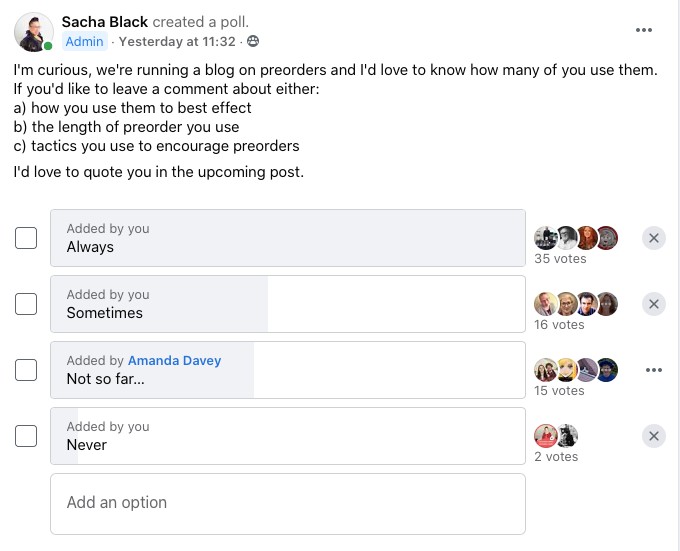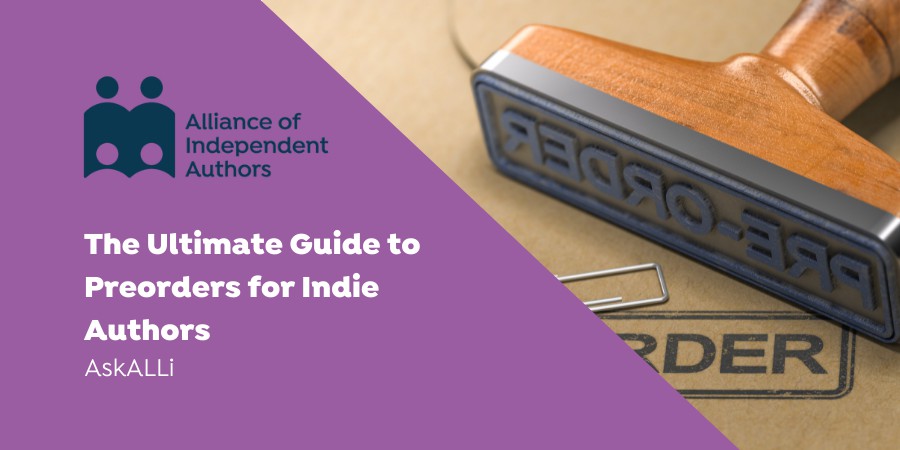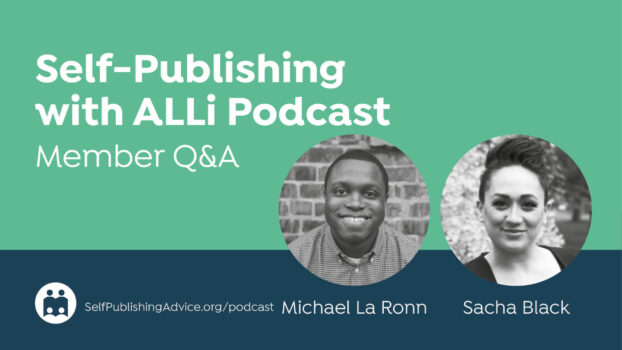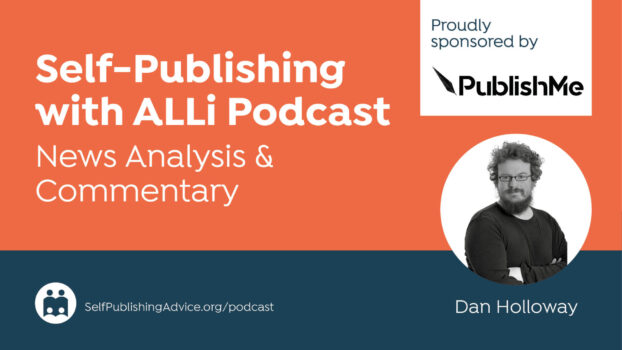The book pre-order market is growing, in trade publishing and author publishing. So how do indie authors use them and how useful are they? That's the topic the Alliance of Independent Authors AskALLi team is answering today. This is the ultimate guide to pre-orders.
What is a Pre-order?
A pre-order is a book sale made in advance of publication. For you, as a publisher, pre-order happen when you enable readers to purchase your book in advance.
Readers don't receive their book until launch day, when the digital book will automatically appear on their e-reader device or audiobook player, or a physical copy will drop through the mail if it's on the day of launch.
How Do the Algorithms Work with Pre-orders?
On Amazon, a pre-order counts only on the day of the order itself. Which means, the longer your pre-order period, the harder it is to sustain a high ranking on that book. This is because the sales are distributed across a longer period rather than being concentrated in one hit.
Other stores, however, don't treat pre-orders like that. Stores like Kobo, Apple, Google Play etc., count the sale on the day of pre-order, but they also give you a ranking boost on the launch day itself.
The art, then, is to run a pre-order when you have a set of activities, adverts or actions you're going to take in order to keep the momentum going on your pre-order.
How Long Should a Pre-order Be?
That depends. Some people use rapid release methods, releasing one book with a link to the next book in the back of the book. That second book may release two weeks later, two months later or another amount of time.
Traditional publishers will often use the full amount of time possible, setting pre-orders of a year or more.
Questions to ask yourself:
- Why do you want a pre-order period?
- How many marketing activities have you got and how long will they last?
- Have you planned out promotions?
- Have you got another book you could discount (with a link to the one on pre-order?)
Not all stores require you to load your files prior to setting up the pre-order. Meaning, if you had the cover and the blurb, you could load up the pre-order without having the content. That said, there's one other thing you need to factor into the pre-order length: there are varying deadlines for loading up the final content files and those deadlines are different for different stores. Always check that you know what the final dates are for each store and that you load up the final content in ample time.
Once the deadline passes (usually a few days before launch) you're unable to change the files. AskALLi team member, Sacha Black, recalls one horrendous occasion when she'd mixed up workbook and textbook files and the pre-order locked and the wrong books were sent out to kindle devices.
“Thankfully, Amazon were able to push the correct content out. But it was a stressful few days. Always, ALWAYS, check your content, make sure it's the right file, use the “launch viewer/look inside” function and double check it all again the day before your pre-order locks.”
Pre-orders by Store
Please note, the timings noted below by store are accurate at the time of writing. You must do due diligence and double check each stores individual requirements when setting up.
- On investigating, Apple didn't have a clear deadline, although one help article suggested 10 days prior.
- Amazon requires that the final file is loaded up no later than 72 hours prior to launch day.
- Kobo ask the same, 48-72 hours before.
- Barnes and Noble also require 72 hours.
- Google Play recommend at least 48 hours but more if you can.
Digital Pre-orders on Your Own Website
Pre-orders from your own website are slightly trickier than standard orders from a digital bookstore. But it's not impossible. ALLi currently places a specific mailing list sign up option on blog posts, or the sales page. Once the book is live, everyone who signed up to find out about the new book is emailed the website purchase link.
However, you could also use a plug in like WooCommerce or Payhip (see our Ultimate Guide to Selling Direct for more information). Like selling a book from your site, you'd integrate with a delivery software like Bookfunnel.
- Set up a purchase page for your book
- Link it to Bookfunnel and a document that explains when and how their book will be delivered
- On launch day, send everyone who has pre-ordered a link to the book
Physical Pre-orders on Your Own Website
Internationally bestselling author and ALLi member Adam Croft runs physical pre-orders from his website. He said:
“Readers buy the book from my shop the same as they would any other, but they don’t get dispatched until just before release day.”
He continued to explain that:
“The price of my books are standard at £8.99. Postage for each sale is calculated automatically by the website based on where the reader is in the world, plus weight/size of parcel. It charges them whatever Royal Mail would charge them. Royal Mail connects into the WooCommerce plugin we use. So this happens automatically. We log into the Royal Mail system every morning and hit a button which prints off all the labels for us.”
AskALLi member Sacha Black has recently done this too. She explained that:
“In order to set up selling both digital and paperback from my site, I use the WooCommerce plugin. I then added two Royal Mail integrations to the plugin. For those not in the U.K. Royal Mail (RM) is the British postal system. The first add-on enabled me to ship physical products. To get it working, I had to add the weight of each book (including envelope) and the dimensions of the parcel to the product information section in my website dash. The RM integration then calculates shipping based off of where the person is in the world. I then added a “Royal Mail Click and Drop” integration. This enables me to login to Click and Drop and download pre-formatted labels. Pay for the printing, print them off and hey presto, parcels are ready to put into a post box.
The benefit of this is that the customer can choose whether they want tracked and insured post, second class post or some other type of shipping.
For pre-orders, I have to set a deadline for readers to order by that's long enough I can then place that order with Ingram Spark, and once the books arrive, I sign them, parcel them up and ship them off in advance of launch day. This works for me because I'm not rapid releasing, but it wouldn't work for anyone on a tight launch deadline.
For paperback selling after launches, I have to hold a small amount of stock. This isn't ideal if you have a tiny office. It's also not necessarily a method for someone if you have difficulties accessing a post box. There's one three feet outside my son's school, so I am close to a post box twice a day which is why this method works for me.”
Pre-order Activities to Generate Buzz and Sales
YouTube sensation, Jenna Moreci, always uses pre-orders to build her launch campaign. Jenna says “Pre-orders are harder to promote because lots of readers like instant gratification with a purchase.”
That's why Jenna uses a pre-order incentive campaign to encourage her readers to order her books in advance. Jenna creates a pre-order sign up sheet, where her readers can tell her their information and upload proof of purchase. She then gives those readers an excerpt of her book. The length of the excerpt varies but it's usually 3-5 chapters of a full length fiction work. Jenna added that:
“This method means everyone is a winner in some way. Everyone who pre-orders gets the teaser chapters, and one lucky winner will also win a big prize.”
As the author, you're also winning because other than postage, you don't incur any additional costs for the teaser chapters. You're already producing the book and having it edited and proofed, the only thing you have to do, is pull a few chapters into a new document. To save you time, batch the mail outs and send the sneak peek chapters once or twice a week.
Jenna also uses giveaways to encourage her readers to pre-order. She collates a pile of goodies, including physical books, merchandise and writer gifts and gives away the lot to one lucky person who pre-ordered her book. This is then announced on launch day.
Member Experiences
We asked our members whether or not they used pre-orders.
- 51% of members always use pre-orders
- 23% sometimes use them
- 22% haven't tried yet
- and just 4% said never

C.J. Archer
“I put pre-orders up before the prior book in the series is released, that way I can grab the pre-order's link and add it to the previous book. When the reader reaches “The End” it's just a single click to pre-order the next book. It's easy for the reader and means they don't have to remember to come back in 6 months time and look for it. It'll just appear on their device when it's available. It means having the cover ready more than 6 months out from release, but it also means I have a stress-free release day as there's less to do.”
Melissa Addey
“Don’t usually like the pressure they bring (I have small kids, pandemics happen…!) but set one up recently for book 2 in a series, mostly so it could get a series page, show readers there’s more books coming, etc.”
Rachel McCollin
“I normally have a 2-3 month pre-order and put the next book on pre-order as the one before is published. For my book that went on pre-order today I'm experimenting with a shorter pre-order and I'm donating all pre-order profits to Covax. I really hope it goes well as I've made my fundraising targets public to my readers and would look very daft if I only sell a few copies.”
Debbie Young
“I only set up pre-orders once I have the cover available, and then I promote it to my mailing list and on social media and my website. I usually only have the cover available at most a month before publication so this means relatively short pre-orders, so I am considering changing my working practices so that I have the cover sooner in order to set up longer pre-orders. However, although I always know the title at the start, I don't always know what the key features should be to put on the cover – so maybe that wouldn't work for me. With my next book, I'm going to do a very short pre-order with the aim of getting a big spike on day 1 and better ratings than if spread out over a long pre-order period. By the way, I have been known to set up a pre-order specifically to make myself finish the damn book!! – so it's not just about sales!”
Adam Nicholls
“Under the permafree strategy provided by Wide for the Win, I have as many pre-orders as possible, looooooong before I even know what the book is about. Readers forget about us when they've eventually gone through our backlog, and there's no better way to remind them than having them wake up to see the latest delivered to their device automatically. For me, that kicks the hell out of newsletters.”
Elise Noble
“I put the pre-order up as soon as I’m sure I can meet a release date. Sometimes a little before that on non-Amazon sites as they’ll let you move the dates without penalty. Always before the release of my previous book so I can put “coming soon” link in the back. I announce the pre-order a month before release in my FB group and two weeks before release in my newsletter, but I don’t market pre-orders other than this.”
“I’ve used pre-orders to generate buzz prior to launch. It also means I have a sales page to send people to as soon as I create excitement with a cover reveal or description reveal. In my experience, there’s little value in generating buzz with reveals if you can’t immediately capitalise on that excitement. People have busy lives and see lots of books. They may love your cover when they see it, but they’ll soon forget about it. So if you can grab the sale then and there then it’s worth it. It’s also useful to be able to link to the next book in the series directly from the back of a new release. However, I don’t always have the cover much ahead of launch and really dislike the pressure of meeting a pre-order deadline. So I only set one up if I am extremely confident of meeting it.”
Sara Rosett
“I always set up pre-orders—ebook on all retailers and print on Ingram Spark. The longer the better for me. I don’t set them up until I have the copy edit back. Pre-orders give me breathing room. They let readers know the series is continuing and they allow me time to get all the versions of the book ready to go—ebook, print, and audio. I don’t release quickly. Pre-orders help me maintain momentum.”
Connor Whiteley
“My business runs off pre-orders. I always use them. Mainly because I use pre-orders to target particular release days. For example, I always put my psychology books up on pre-orders for September and January because these are the beginnings of the academic term and I sell a lot during these months anyway. So I might as well take advantage of this nature increase in sales and traffic.
In terms of fiction, I always like to have something ready to release end of July/ early August because of the summer holiday increase in sales. And I like to have a pre-order for early November for the Christmas gift giving season.Regardless of genre or brand, I always do pre-orders for at 3 months but I do have pre-order at the moment for 5 months. I prefer to do pre-orders for as long as possible.
I don't really push pre-orders to hard because nonfiction pre-orders on IS for me tend go extremely well. But I still email my lists and mention the pre-orders on my podcasts.”
“I normally have a 2-3 month pre-order and put the next book on pre-order as the one before is published. For my book that went on pre-order today I'm experimenting with a shorter pre-order and I'm donating all pre-order profits to Covax. I really hope it goes well as I've made my fundraising targets public to my readers and would look very daft if I only sell a few copies.”




